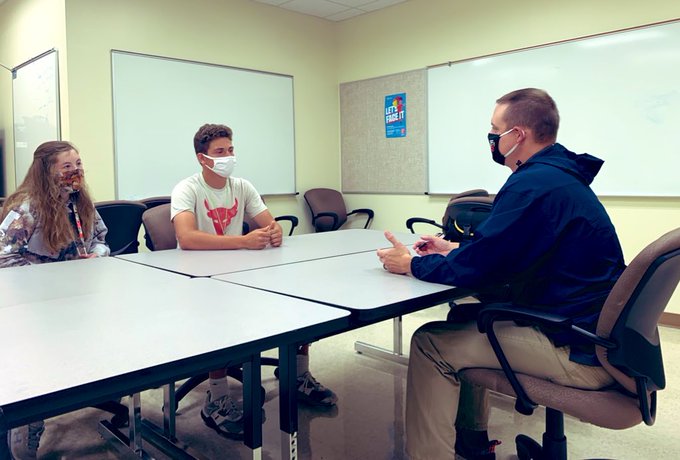Silver Linings Series: Remembering a historic school year with Westridge Middle School
Silver Linings Series: Remembering a historic school year with Westridge Middle School
By Tyler Dahlgren
The 2020-2021 school year is in the books, and given its complexities will likely hold its own chapter for a very long time.
Historic, challenging, unprecedented. You’ve heard those before. It was all that, and now, it’s complete.
It’s June, time for a deep breath. Educators and students alike have earned a moment to reset, and sometimes the best way to recharge the batteries is to reflect.
We caught up at the finish line with Grand Island’s Westridge Middle School to take a long look back and, more importantly, a hopeful look forward. From silver linings to lessons learned and a new appreciation for the sometimes mundane routineness of school life, two students, two teachers and a principal spent an hour covering it all.
This is the 2020-2021 school year through their eyes.
Grand Island Public Schools went the distance.
It wasn’t easy, and it took trust, sacrifice and flexibility, but the district was able to remain open from the first day of school through the last.
To that, Westridge Middle School principal Brad Wolfe credits the plan put together by the district’s leadership team and the protocols that were carefully considered before being put into place.
But the star of the show? That one’s easy.
“The kids are the winners here,” Wolfe said. “When the winter protocols came out and they learned they’d be wearing masks and social distancing, they really adjusted. Sometimes, I feel they adjusted better than the adults did. They came in accepting why those were in place and understood that there were going to be some changes made. We were just trying to keep school open. We wanted kids here at school learning.”
No, it wasn’t easy. Mentally, the social distancing and the masks and the fall without sports or activities wore on everyone. Some students ate lunch in the cafeteria, some students ate lunch on the wrestling deck. Some were in class every day, some missed extended periods of time due to a number of circumstances, many of which were out of their control.
“Through all of that, our students did a great job of being resilient all year long,” Wolfe said.
Students Brady Douglass and McKartni Norton remember feeling like most everybody else when the pandemic brought the world to a screeching halt and closed schools across the globe last March. Scared, confused, worried. Those feelings were alleviated some when it was announced that GIPS would return to in-person learning in the fall, and even more so when they returned to Westridge for the first day of school (eighth-grade for Douglass and seventh for Norton).
“It was relieving just knowing that we were going to be able to have that personal experience with school again,” said Norton. “I’m not great with technology, and it was hard to keep my grades steady while being remote, so I was thankful to be back in school.”
Though Douglass was disappointed about missing out on a year of football after fall activities were cancelled, he appreciated being back in the building, too.
“I was just happy to see my friends again, who I hadn’t seen all summer,” he said. “I was glad to be back, even if we had to wear a mask.”
Though aware of the fact that they were stepping into a once-in-a-career juggling act, Westridge educators were glad to be back, too. Especially after a summer of operating in an imminent state of unknown and a spring semester of simply surviving the stress and, to be frank, strangeness.
Middle school students are at an interesting age, old enough to take care of their younger siblings (which many did from March to May), and young enough to experience a sharp dose of reality when transitioning without warning to learning in a digital world and shouldering the responsibilities that followed.
“Just seeing how responsible these kids are, that was eye-opening,” said seventh-grade math teacher Kayla Geiger. “I didn’t learn the skills they now have until I went to college and had online classes and had to do stuff on my own. Some of these kids are already learning on their own. As seventh-graders, they’re learning what most eighteen and nineteen-year-olds are just figuring out. They’re going to be awesome when they get to that point.”
It’s just one of many silver linings that could end up coming out of pandemic, though it’s difficult to look at the situation through that wide of a lens just yet. Another was the trust that developed between teachers and their students.
“I was always hesitant to give a ton of student choice on projects or assignments, but now I understand that if I give more choice, I receive more buy-in, more participation,” said Grant Hiebner, who teaches 7th-grade social studies at the school. “I’ve gotten some really unique projects, too. Giving a choice and some flexibility and seeing what they come up with, a lot of students responded to that.”
To see those results, they had to work in synch through ever-changing circumstances. The only way to do so productively was by widening lines of communication. Families became a critical piece to their student’s success and, for the most part, supported the school’s protocols and safety measures.
“I give kudos to our parents, they were very accepting no matter what their beliefs were,” Wolfe said. “They understood the protocols and were supportive of what we had to do to keep the kids in school.”
They’ll likely never admit it, at least not all at once, but Geiger has a hunch that, deep down, kids enjoy the structure of a school day. Teachers sense that type of thing after a long weekend or a holiday break, but it was unmistakable throughout this school year. Students did their part in keeping the doors open.
“No one really went around and told anyone to put their mask up or to keep it on,” Douglass said. “It was just kind of expected of you to do it because everyone else was.”
The kids were asked to mature quickly, Douglass explained, just one of a surprisingly high number of areas of growth set in motion by the pandemic.
“We learned what it means to be accountable,” said Norton. “We realized and accepted that this is what we needed to do if we wanted to stay safe and move on.”
As a principal, it’s important to Wolfe to keep a gage on his school’s climate. Obviously, that was next to impossible last spring, but this most unconventional stretch has left him with a deeper appreciation for the need of doing so.
“You really did see how people struggle with isolation,” he said. “Even when we go back to normal, we’re doing so more cognizant of people’s needs as far as how our building could be a place of comfort.”
Systems of support varied from person to person, but Wolfe and other GIPS administrators worked to ensure that they were available for students and staff, too.
“They (district administration) were always checking in on the climate of the teachers and the climate with the kids and how things were going for us and how we were feeling,” said Geiger. “They did their best to help out with morale.”
In the same way that teachers became flexible with students, the administration became flexible with teachers. For educators with children of their own at home, being able to attend professional development days virtually from home was much appreciated.
“We have had a lot of staff out of the building at one point or another, and they’ve been mindful of those situations, telling us to take care of ourselves and our families,” Hiebner said.
There was a lot of give and take all around, Wolfe said. The administration welcomed input from the staff and encouraged ideas. If it was something that could benefit a student, the idea was usually allowed. Innovation was fostered in a time when it was needed the most, and some of the results stand as another silver lining.
“We actually used a lot of the stuff we created last spring this year because it worked so well,” Hiebner said.
Wolfe tried to trickle in positive energy when he could, especially during the morning announcements, a ritual that has since been taken over by a rotation of students. It was a difficult year, but it wasn’t devoid of fun and the pandemic didn’t succeed in taking any more memories. Nope, those were still made.
“Being able to laugh with your classmates, that’s what I’ll remember the most,” said Norton. “Lunch was different. A lot of my friends who were in my class during the lunch period weren’t able to rotate tables, so I sat with other kids and got to know them better on a personal level.”
That kind of perspective is rare for a girl who just finished the 7th-grade, but these aren’t your average middle school students and this wasn’t your average school year.
The key ingredient to reaching the finish line?
“Grace,” said Geiger. “We all had a mutual respect for the situation, and that was the biggest thing with teachers and students, allowing grace to everyone.”
Things are starting to look normal again. School’s out for the summer. The dog days of June and July are back, and the kids have earned this one.
“I’m excited to go up to the senior high and to play football in the fall,” said Douglass. “Also, I just want to go to the pool.”
School’s a few months off, but McKartni Norton already lights up when asked about experiencing the eighth-grade in a more traditional environment.
“I’m most excited to see people’s faces again, to see how they react to different things and to see people smile again,” she said.
The kids aren’t the only ones who’ve earned a brief reprieve.
“The break will be nice,” said Hiebner. “Teachers in this school have been awesome. We’ve sacrificed time at the beginning and end of the day, every single day, and we needed to have these structures in place so that students can be in the building. We understand that. I’m proud of the whole staff, and the students, too, and we’re glad to be back, but it’s time for a little bit of a break, a little bit of rest.”
Ten years down the road, Gieger and her colleagues will look back at this school year with plenty to be proud of. They’ll think of the trials and tribulations briefly before spending twice as long as the sacrifices and successes.
“We made it,” she said. “We made it through the entire school year without being shut down. We made it through all of the standards that we needed to teach, and the kids have grown a lot.”
It’s 80 degrees and sunny today in Grand Island, with only a few clouds in sight.
Hopefully somewhere Brady Douglass is with his friends cannonballing into a swimming pool, just as he should be.



